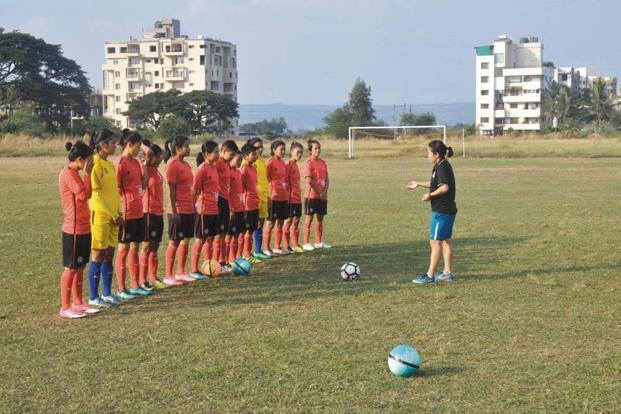Despite women playing the sport across India, the game hasn’t received the attention that it deserves

Eastern Sporting Union in Kolhapur. Photo credit: Shail Desai
First published: https://www.livemint.com/Sports/73nWatiHRsz9pwXQtd54DL/Bad-planning-lack-of-teams-hurt-womens-football-league.html
Bad planning, lack of teams hurt Indian women’s football
Most ISL and I-League clubs do not have a regular women’s team; they assemble one for competitions
In November, football club Eastern Sporting Union (ESU) made the long trip from Imphal to Kolhapur to play the qualifiers of the second Indian Women’s League (IWL). It involved two flights to Mumbai, an overnight stay, followed by a night train to Kolhapur.
As the defending champions, ESU had requested entry into the final round, but were told that four berths were reserved for two I-League and Indian Super League (ISL) teams each. The two teams that topped their respective pools in the qualifiers would join them in the final round.
For the next three weeks or so, ESU slogged it out with a pool of just 13 players, as five others had not been given permission to play by their employers. It took a heartening effort for them to top their pool, while Cuttack-based Rising Student Club took the top spot in the other—these are the two sides that played the final last year.
By the time the final round, scheduled for March, arrived, all the I-League and ISL clubs, other than Gokulam Kerala, had pulled out. Consequently, Kryphsa (Kangchup Road Young Physical and Sports Association), the India Rush Soccer Club, Sethu FC and Indira Gandhi Academy, which had featured in the qualifiers, were asked to play again to make up the numbers.
The qualifiers turned out to be a pointless exercise for ESU—four teams that failed to qualify made it to the final round—and by the end of it, they had spent Rs8.5 lakh just on the travel, besides another Rs3.2 lakh on preparations for the tournament.
“Why should the defending champions play the qualifiers, only to face the same teams again in the final round? The lack of organization really affects a club like ours,” says an ESU official, requesting anonymity. The final round is currently under way.
The IWL only started last season. Most players still need a day job to make a living—a stark contrast to their male counterparts, who have had a league since the National Football League was started in 1996. For the record, the Indian women’s team is ranked 59th in the world and 13th in the Asian Football Confederation—Indian men are ranked 99 in the world.
Most ISL and I-League clubs do not have a regular women’s team—they assemble one for competitions. But in the case of this year’s IWL, many of them didn’t bother.
When it comes to women’s football, the All India Football Federation’s (Aiff’s) role so far has been restricted mostly to organizing tournaments, though it’s not short of funds. According to Fifa.com, “FIFA, through its Forward Programme, invests money back into the game by working together with member associations…with India seeing $700,000 contributed to establish a women’s league in the country: the Indian Women’s League (IWL).”
“We had only the nationals initially, but now there is the IWL. It’s good for the development of the game, yet more needs to be done,” says Shukla Datta, head coach of the Rising Student Club.
While Aiff runs many grass-roots programmes, they only last for a day or two. Most of the work on real development is still being executed by feeder clubs such as the ESU, Kryphsa (also based out of Imphal) and Rising Student Club—and on their own strength.
Though Mumbai-based India Rush SC currently have no local players, they are grooming many age-group sides for the future. Similarly, Sethu FC’s core comprises players from their home state of Tamil Nadu. Club owner M. Seeni Mohaideen not only tends to their football needs, but also looks after their education.
One of the oldest sides in women’s football, ESU have been running a team since 1973, yet they had to depend on donations from patrons until they managed to get support last year from Tata Trusts, as well as Four Corners Unite—an initiative by Mumbai resident Tejesh Sharma. While that meant they had enough funds to play the tournament, ESU would have preferred to use these for player development.
The club has recruited over 50 girls for different age categories—some from underprivileged backgrounds— and is grooming them for the national team, which currently has seven players from the club.
“How do we justify this expenditure on a tournament when we’ve taken on the responsibility of grooming so many more? In Manipur, football can help these girls get jobs. We would rather invest money in making players, than play qualifiers which have no meaning,” the ESU official says.
Few want to invest in women’s football. “Most of these I-League and ISL teams have a budget for men’s teams, but don’t see an incentive to start a women’s side. Teams such as ESU and Kryphsa have groomed their girls over the years, so their players are loyal. We too want to do the same in the future,” says an official from India Rush SC who did not wish to be identified.
While individual efforts are laudable, it’s time perhaps for Aiff to focus more on the grass roots.